You are using an out of date browser. It may not display this or other websites correctly.
You should upgrade or use an alternative browser.
You should upgrade or use an alternative browser.
THe Sherassic Park - A PaLeontologic adventure
- Thread starter LeonardoBjj
- Start date
- Joined
- Jan 17, 2010
- Messages
- 4,529
- Reaction score
- 5,492
New ‘Giant’ Species of Long-Necked Dinosaur Discovered in Spain
The prehistoric creature, named Garumbatitan morellensis, may help paleontologists unravel the evolution of the plant-eating sauropods
Sarah Kuta
Daily Correspondent
October 5, 2023
:focal(1304x981:1305x982)/https://tf-cmsv2-smithsonianmag-media.s3.amazonaws.com/filer_public/3e/8d/3e8d0b6a-51e1-4c3b-b63f-c374fcaa8eb4/garumbatitan_fig1a.jpg)
Around 122 million years ago, large, long-necked dinosaurs tramped around the land that is present-day Spain. Paleontologists recently unearthed the fossilized remains of some of these massive creatures, which they’ve identified as a new species.
Named Garumbatitan morellensis, the newly discovered behemoths could help researchers understand the evolution of sauropods, a group of four-legged, plant-eating dinosaurs with long necks and tails.
“This new sauropod is one of the best-preserved sauropods found in the Lower Cretaceous of Europe, which provides us key information about the evolutionary history of the group in this geographic domain,” Pedro Mocho, a paleontologist at the University of Lisbon, tells Newsweek’s Aristos Georgiou.
Mocho and other researchers shared their findings in a new paper published last week in the Zoological Journal of the Linnean Society.
G. morellensis is a member of a sauropod subgroup called Somphospondyli, which roamed far and wide throughout the Cretaceous period. Paleontologists have found fossils of somphospondylans all over the world, so they’ve had a hard time figuring out where the creatures may have originated.
But the discovery of G. morellensis in Spain adds another pin to the map. And, since G. morellensis is a “primitive” member of the group, scientists say it’s possible that somphospondylans originally hailed from Europe, then fanned out to what is now Asia, North America and Africa, writes Live Science’s Harry Baker.
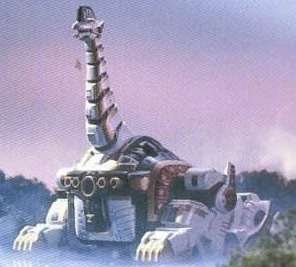
A team of Spanish and Portuguese paleontologists uncovered G. morellensis’ remains while working at the Sant Antoni de la Vespa fossil site between 2005 and 2008.
The region, which is located near the city of Morella in eastern Spain, has produced numerous dinosaur fossils. But researchers say many more remain buried, and further excavations could help reveal even more about its past.
“Here in this region, we say that ‘tota pedra fa paret’—every stone makes a wall—and this stone is helping to build the paleontological wall, because it is big,” says study co-author José Miguel Gasulla, a paleontologist at Spain’s National University of Distance Education (UNED), to El País’ María Pitarch.
They discovered vertebrae, leg bones and foot bones, which they believe belonged to at least three separate G. morellensis individuals. These sets of remains likely date to the Early Cretaceous period, which spanned roughly 145 million to 100.5 million years ago.
The foot bones were especially noteworthy, as paleontologists unearthed “two almost complete and articulated feet,” which is “particularly rare in the geological record,” Mocho says in a statement.
They can’t tell exactly how large G. morellensis could have grown. But they do know from the creatures’ bones that it was massive: Some of the vertebrae they discovered were 3.3 feet wide, and one of the femurs was 6.6 feet long. According to their estimates, these dinosaurs may have been 33 feet tall and likely ate between 66 and 88 pounds of vegetation each day, per El País.
The dinosaur’s name is also a nod to its colossal size, as well as the geography of the region, according to the statement. Garumbatitan means “the giant of the Garumba” and refers to Muela de la Garumba, a mountain peak in the Els Ports region of Spain near where the fossils were discovered. Morellensis, meanwhile, is a reference to the nearby city of Morella.
https://www.smithsonianmag.com/smar...ecked-dinosaur-discovered-in-spain-180983013/
The prehistoric creature, named Garumbatitan morellensis, may help paleontologists unravel the evolution of the plant-eating sauropods
Sarah Kuta
Daily Correspondent
October 5, 2023
:focal(1304x981:1305x982)/https://tf-cmsv2-smithsonianmag-media.s3.amazonaws.com/filer_public/3e/8d/3e8d0b6a-51e1-4c3b-b63f-c374fcaa8eb4/garumbatitan_fig1a.jpg)
Around 122 million years ago, large, long-necked dinosaurs tramped around the land that is present-day Spain. Paleontologists recently unearthed the fossilized remains of some of these massive creatures, which they’ve identified as a new species.
Named Garumbatitan morellensis, the newly discovered behemoths could help researchers understand the evolution of sauropods, a group of four-legged, plant-eating dinosaurs with long necks and tails.
“This new sauropod is one of the best-preserved sauropods found in the Lower Cretaceous of Europe, which provides us key information about the evolutionary history of the group in this geographic domain,” Pedro Mocho, a paleontologist at the University of Lisbon, tells Newsweek’s Aristos Georgiou.
Mocho and other researchers shared their findings in a new paper published last week in the Zoological Journal of the Linnean Society.
G. morellensis is a member of a sauropod subgroup called Somphospondyli, which roamed far and wide throughout the Cretaceous period. Paleontologists have found fossils of somphospondylans all over the world, so they’ve had a hard time figuring out where the creatures may have originated.
But the discovery of G. morellensis in Spain adds another pin to the map. And, since G. morellensis is a “primitive” member of the group, scientists say it’s possible that somphospondylans originally hailed from Europe, then fanned out to what is now Asia, North America and Africa, writes Live Science’s Harry Baker.

A team of Spanish and Portuguese paleontologists uncovered G. morellensis’ remains while working at the Sant Antoni de la Vespa fossil site between 2005 and 2008.
The region, which is located near the city of Morella in eastern Spain, has produced numerous dinosaur fossils. But researchers say many more remain buried, and further excavations could help reveal even more about its past.
“Here in this region, we say that ‘tota pedra fa paret’—every stone makes a wall—and this stone is helping to build the paleontological wall, because it is big,” says study co-author José Miguel Gasulla, a paleontologist at Spain’s National University of Distance Education (UNED), to El País’ María Pitarch.
They discovered vertebrae, leg bones and foot bones, which they believe belonged to at least three separate G. morellensis individuals. These sets of remains likely date to the Early Cretaceous period, which spanned roughly 145 million to 100.5 million years ago.
The foot bones were especially noteworthy, as paleontologists unearthed “two almost complete and articulated feet,” which is “particularly rare in the geological record,” Mocho says in a statement.
They can’t tell exactly how large G. morellensis could have grown. But they do know from the creatures’ bones that it was massive: Some of the vertebrae they discovered were 3.3 feet wide, and one of the femurs was 6.6 feet long. According to their estimates, these dinosaurs may have been 33 feet tall and likely ate between 66 and 88 pounds of vegetation each day, per El País.
The dinosaur’s name is also a nod to its colossal size, as well as the geography of the region, according to the statement. Garumbatitan means “the giant of the Garumba” and refers to Muela de la Garumba, a mountain peak in the Els Ports region of Spain near where the fossils were discovered. Morellensis, meanwhile, is a reference to the nearby city of Morella.
https://www.smithsonianmag.com/smar...ecked-dinosaur-discovered-in-spain-180983013/
- Joined
- Jan 17, 2010
- Messages
- 4,529
- Reaction score
- 5,492
'Juvenile T. rex' fossils are a distinct species of small tyrannosaur
Date:January 2, 2024Source:University of Bath
Summary:A new analysis of fossils believed to be juveniles of T. rex now shows they were adults of a small tyrannosaur, with narrower jaws, longer legs, and bigger arms than T. rex. The species, Nanotyrannus lancensis, was first named decades ago but later reinterpreted as a young T. rex. The new study shows Nanotyrannus was a smaller, longer-armed relative of T. rex, with a narrower snout.

The first skull of Nanotyrannus was found in Montana in 1942, but for decades, paleontologists have gone back and forth on whether it was a separate species, or simply a juvenile of the much larger T. rex.
Dr Nick Longrich, from the Milner Centre for Evolution at the University of Bath (UK), and Dr Evan Saitta, from the University of Chicago (USA) re-analysed the fossils, looking at growth rings, the anatomy of Nanotyrannus, and a previously unrecognized fossil of a young T. rex.

Measuring the growth rings in Nanotyrannus bones, they showed that they became more closely packed towards the outside of the bone -- its growth was slowing. It suggests these animals were nearly full size; not fast-growing juveniles.
Modelling the growth of the fossils showed the animals would have reached a maximum of around 900-1500 kilograms and five metres -- about 15 per cent of the size of the giant T. rex, which grew to 8,000 kilograms and nine metres or more.
The researchers have published their findings in Fossil Studies.
"When I saw these results I was pretty blown away," said Longrich. "I didn't expect it to be quite so conclusive.
"If they were young T. rex they should be growing like crazy, putting on hundreds of kilograms a year, but we're not seeing that.
"We tried modeling the data in a lot of different ways and we kept getting low growth rates. This is looking like the end for the hypothesis that these animals are young T. rex."
Supporting the existence of distinct species, the researchers found no evidence of fossils combining features of both the Nanotyrannus and T. rex - which would exist if the one turned into the other. Every fossil they examined could be confidently identified as one species or the other.
Neither did the patterns of growth in other tyrannosaurs fit with the hypothesis that these were young T. rex.
Dr Longrich said: "If you look at juveniles of other tyrannosaurs, they show many of the distinctive features of the adults. A very young Tarbosaurus - a close relative of T. rex - shows distinctive features of the adults.
"In the same way that kittens look like cats and puppies look like dogs, the juveniles of different tyrannosaurs are distinctive. And Nanotyrannus just doesn't look anything like a T. rex.
"It could be growing in a way that's completely unlike any other tyrannosaur, or any other dinosaur- but it's more likely it's just not a T. rex."
But that raises a mystery -- if Nanotyrannus isn't a juvenile Tyrannosaurus, then why hasn't anyone ever found a young T. rex?
"That's always been one of the big questions. Well, it turns out we actually had found one," said Longrich. "But the fossil was collected years ago, stuck in a box of unidentified bones in a museum drawer, and then forgotten."
The research led Longrich and co-author Evan Saitta to a previous fossil discovery, stored in a museum in San Francisco which they identified as a juvenile Tyrannosaurus.
That young T. rex is represented by a skull bone -- the frontal bone -- with distinctive features that ally it with Tyrannosaurus, but which aren't seen in Nanotyrannus. It comes from a small animal, one with a skull about 45 cm long and a body length of around 5 metres.
Dr Longrich said: "Yes, it's just one specimen, and just one bone, but it only takes one. T. rex skull bones are very distinctive, nothing else looks like it. Young T. rex exist, they're just incredibly rare, like juveniles of most dinosaurs."
The researchers argue these findings are strong evidence that Nanotyrannus is a separate species, one not closely related to Tyrannosaurus. It was more lightly-built and long-limbed than its thick-set relative. It also had larger arms, unlike the famously short-armed T. rex.
"The arms are actually longer than those of T. rex. Even the biggest T. rex, has shorter arms and smaller claws than in these little Nanotyrannus. This was an animal where the arms were actually pretty formidable weapons. It's really just a completely different animal -- small, fast, agile.
"T. rex relied on size and strength, but this animal relied on speed."
The long arms and other features suggest it was only distantly related to T. rex - and may have sat outside the family Tyrannosauridae, which T. rex is part of, in its own family of predatory dinosaurs.

The new study is the latest in a series of publications on the problem, going back decades.
Longrich said: "Nanotyrannus is highly controversial in paleontology. Not long ago, it seemed like we'd finally settled this problem, and it was a young T. rex.
"I was very skeptical about Nanotyrannus myself until about six years ago when I took a close look at the fossils and was surprised to realise we'd gotten it wrong all these years."
The authors suggest that, given how difficult it is to tell dinosaurs apart based on their often-incomplete skeletons, we may be underestimating the diversity of dinosaurs, and other fossil species.
Longrich said: "It's amazing to think how much we still don't know about the most famous of all the dinosaurs. It makes you wonder what else we've gotten wrong."
https://www.sciencedaily.com/releases/2024/01/240102190920.htm
@Tyrannosaurus rex
- Joined
- Nov 18, 2017
- Messages
- 13,485
- Reaction score
- 15,617
Mind blowing
- Joined
- Jan 17, 2010
- Messages
- 4,529
- Reaction score
- 5,492
When I saw Sherassic park I thought of a park with hot grannies.
I”ll show myself out.
- I love MILF's too!
- Joined
- Jan 17, 2010
- Messages
- 4,529
- Reaction score
- 5,492
Mind blowing
- We dont know almost nothing from or sea today. Can you imagine the things that used to live millions of years ago?
- Joined
- Jan 17, 2010
- Messages
- 4,529
- Reaction score
- 5,492
Giganto, largest ever primate, died out due to diet change, say scientists
Giant primate ate bark and twigs after climate change turned sub-tropical environment into savannah
Gigantopithecus blacki roamed mainland south-east Asia about 2 million years ago Photograph: Garcia/Joannes-Boyau/Southern Cross University
It was the largest primate ever to have roamed the Earth, but just why – and when – our distant cousin “giganto” ended up extinct has been something of a mystery.
Now researchers say the enormous ape was victim of an unfortunate choice of food when its preferred snacks became scarce.
Gigantopithecus blacki roamed mainland south-east Asia 2 million years ago, with estimates suggesting it was three metres tall and weighed 200-300kg – roughly three to four times a human’s weight.
Previous studies have shown giganto’s range decreased considerably by about 330,000 years ago, but unpicking the cause of its extinction has been a challenge as it was unclear when exactly it was wiped out.
Dr Kira Westaway of Macquarie University, co-lead author of the study, said: “If you don’t have an accurate timeline, then you’re just looking for clues in the wrong places.

“It was assumed that the deterioration in forests was the cause of its demise as it couldn’t live in open grasslands – but our study shows that this [shift to savannah] occurred at about 200,000 [years ago] when G blacki was already extinct.”
Writing in the journal Nature, Westaway and colleagues report how they used a host of techniques to date giganto teeth from 11 caves in China, as well as the cave sediments. They also dated sediments from 11 caves where no giganto remains were found.
The results revealed giganto died out between 295,000 and 215,000 years ago. The researchers then pieced together the environmental conditions in which giganto lived, analysing pollen, animal fossils and sediments within the caves, together with stable isotopes of carbon and oxygen.
The results suggest about 700,000 to 600,000 years ago giganto’s environment began to shift from dense forests with patches of grassland, to more open forests – apparently a result of climate change away from fairly stable conditions.
“We’re getting a very strong wet season and a very strong dry season,” Westaway said.
This changed the forest plant communities, and meant fruits that had been available year-round were scarce during drier periods.
The team explored the changing diet of giganto by analysing wear patterns on its teeth as well as its internal chemical makeup. They compared the findings with those from the Chinese orangutan, a close relative that went extinct much later.
The results suggest the orangutan feasted on leaves and flowers from the forest canopy in lieu of fruit. However, giganto – which was less mobile and able to forage – took a different approach. “The key to [the apes’] survival was what they use as a fallback food,” said Westaway. “Giganto chose a very unnutritious backup food – he was eating really fibrous things like bark and twigs on the floor.”

By about 300,000 years ago giganto populations were struggling. “Giganto, being a very specialist feeder and habitat specialist, just really couldn’t adapt,” said Westaway.
Prof Hervé Bocherens of the University of Tuebingen, who was not involved in the study, said earlier research of his had also highlighted a lack of flexibility was behind giganto’s demise, suggesting it stuck with a diet of plants from a densely forested landscape even when other species at the same site consumed grass from savannah environments.
But, he added: “Our previous work did not benefit from the same robust chronological framework as this new paper, so we could not develop a scenario as detailed as the authors did.”
Westaway said the research had important implications, given concerns over a sixth mass extinction. “It’s really important to understand how primates respond to environmental stresses and how some species are more vulnerable and some are more resilient,” she said.
https://www.theguardian.com/science...te-died-out-due-to-diet-change-say-scientists
- Joined
- Aug 4, 2023
- Messages
- 2,119
- Reaction score
- 3,278
Imagine the stink of that thing.
- Joined
- Jan 17, 2010
- Messages
- 4,529
- Reaction score
- 5,492
Mummified skin from creature that lived 290 million years ago is older than the dinosaurs
By Carys Matthews
Crocodile-like skin from a reptile is 130 million years older than the previous record for fossilized skin, researchers say.
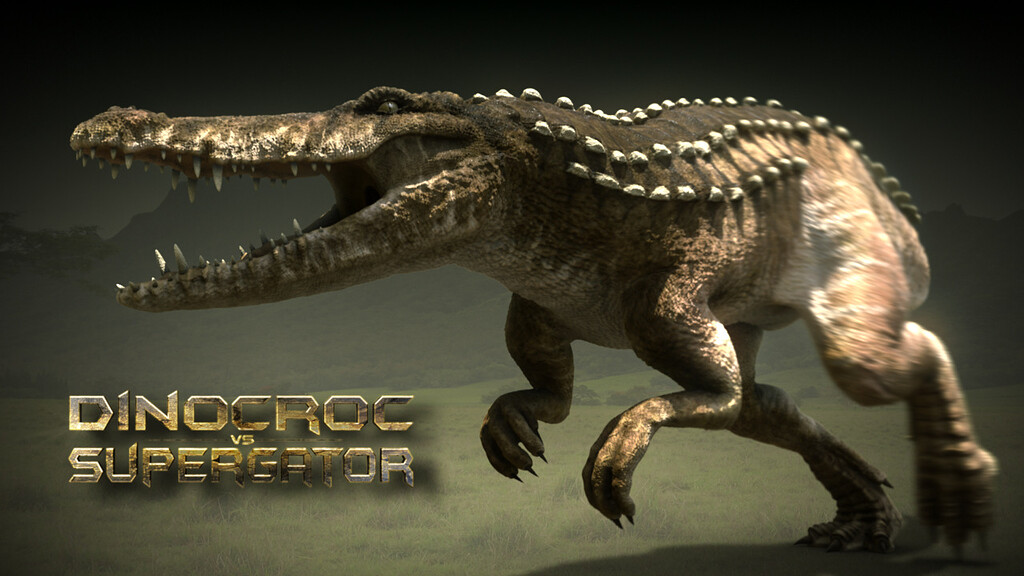
Crocodile-like skin belonging to an early species of reptile is the oldest fossilized skin ever discovered, dating back almost 290 million years — 130 million years older than the previous record holder.
The skin, dating from the Paleozoic era (541 million to 252 million years ago), has similar features to that of other ancient reptile species, with pebble-like, non-overlapping scales, which most closely resemble the extinct Cretaceous (145 million to 66 million years ago) dinosaur Edmontosaurus and crocodile skin. Hinged regions between the epidermal scales resemble the skin structures found in snakes and worm lizards, paleontologists noted in a new study.
"It was mind blowing when we realized this was technically the oldest piece of a proper mummified skin," study co-author Ethan Mooney, a University of Toronto paleontology graduate, told Live Science. "Impressions of skin are rare in the fossil record, but more common than proper mummified skin. "Our skin cast (which is mummified skin), is 130 million years older than the oldest example of proper mummified skin, most of which comes from dinosaurs."
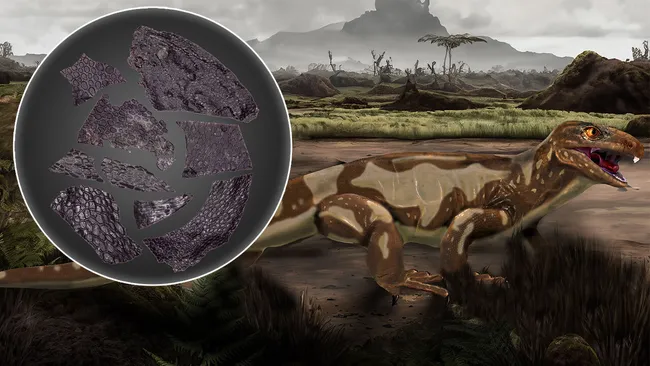
Artist impression of the reptile-like creature that the skin came from. (Image credit: Artist impression (Michael deBraga) and skin fossil image (Current Biology Mooney et al))
The previous oldest confirmed skin fossil came from a dinosaur, lead author Robert Reisz told Live Science. He added that there is another fossil from Russia that is 21 million years younger, but the specimen needs to be restudied to confirm it is skin.
According to the study, published Jan. 11 in the journal Current Biology, the skin fossil is the oldest known example of a preserved epidermis — the outermost layer of skin found in terrestrial reptiles, birds and mammals. The structure could have been vital to species' transition and survival from aquatic to fully terrestrial environments, because it protected their organs from the elements.
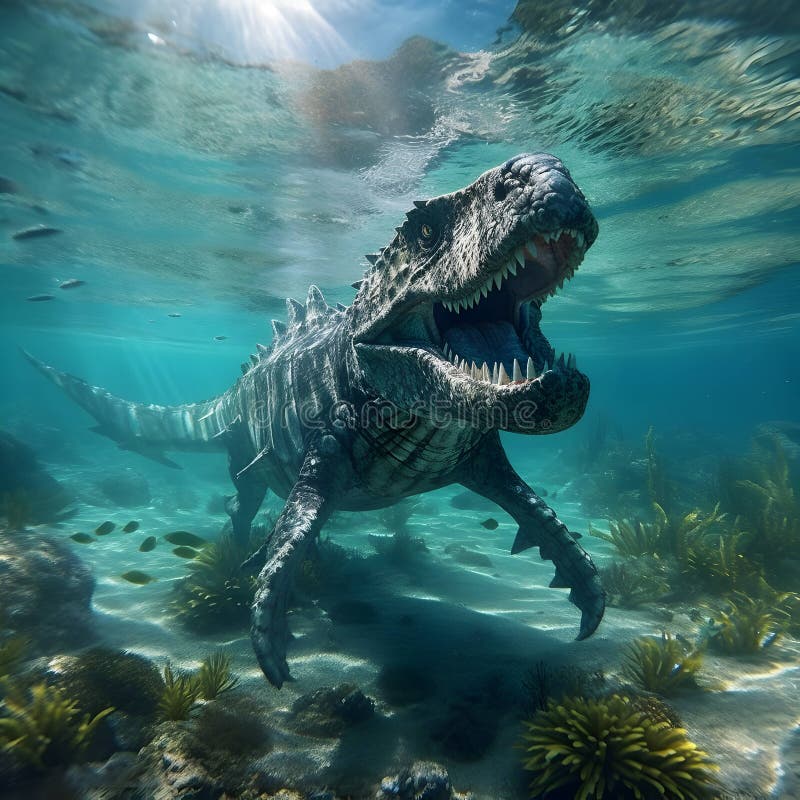
Dinocroc isnt real representation
The tiny fingernail-size skin fossil was found preserved in clay sediments in Richards Spur limestone cave system in Oklahoma, along with other specimens. Although skin and soft tissues are rarely fossilized, researchers say the cave system’s complex composition of fine clay sediments combined with oil seepage in an oxygenless environment likely slowed decomposition and preserved the sample.
When researchers examined the fossil under a microscope, they found epidermal tissues that are commonly found in the skin of amniotes — a terrestrial vertebrate group consisting of reptiles, birds and mammals that evolved from amphibian ancestors during the Carboniferous period.
At the time this creature lived, dinosaurs were yet to emerge and animals consisted of four-legged vertebrates which were fish-like in appearance. According to a study from 2009, these early tetrapods would have resembled crocodiles, lizards, eels and snakes.
Mooney said these ancient ancestors would have looked "very reptilian if you saw them today," adding that the "mummified skin and associated impressions likely show us what the skin would have been like in these ancestral reptiles."
However, as no skeleton or other remains were found, researchers say it isn't possible to identify the species of animal or even the part of the body the skin originated from.
Mooney said discovering fossilized skin resembling that seen in living animals today shows it was "critical for their success on land." This early skin, and the novel structures within, enabled creatures to move from aquatic environments to terrestrial habitats, eventually leading to the evolution of birds, mammals and reptiles, the authors wrote.
https://www.livescience.com/animals...million-years-ago-is-older-than-the-dinosaurs
- Joined
- Jan 17, 2010
- Messages
- 4,529
- Reaction score
- 5,492
Newfound T. rex relative was an even bigger apex predator, remarkable skull discovery suggests
The newly identified tyrannosaur species is the closest known relative of T. rex and could have been even larger than the famous dinosaur king.
Paleontologists have uncovered a never-before-seen tyrannosaur species in North America that has been masquerading as a Tyrannosaurus rex for decades. The newly identified species is the closest known relative of T. rex and could have been even larger than the dinosaur king, a new study shows.
The newfound sister species, Tyrannosaurus mcraeensis, was identified from a partial fossilized skull that paleontologists unearthed in 1983 while exploring the Hall Lake Formation in New Mexico. The calcified cranium was originally classified as a T. rex skull and has been displayed at the New Mexico Museum of Natural History and Science (NMMNHS) ever since. But in 2013, a team of paleontologists decided to reevaluate the skull after noticing subtle yet suspicious anomalies in its shape.
In a new study published Thursday (Jan. 11) in the journal Scientific Reports, the team revealed that the skull dates to between 73 million and 71 million years ago during the Cretaceous period (145 million to 66 million years ago). This makes T. mcraeensis between 3 million and 5 million years older than T. rex.
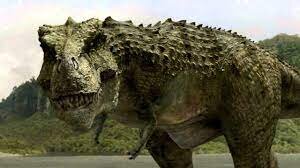
Speckles: The Tarbosaurus
The stark age difference was the main giveaway that they had discovered a new species. But there were also major morphological differences that stand T. mcraeensis apart from the infamous dinosaur king.
"The most striking difference is the shape of the lower jaw, which is more slender and curved [than T.rex]," study co-author Nick Longrich, a paleontologist at the University of Bath in the U.K., told Live Science. "It also lacks the prominent bosses or hornlets found over the top of the eyes in T. rex."
T. mcraeensis also has fewer teeth than most other tyrannosaurs, which is one of the main reasons why the researchers believe it is T. rex's closest relative — because T. rex also has fewer teeth, Longrich said.
The size of the skull suggests this particular T. mcraeensis was around the same size as a typical adult T. rex, which grew to around 39 feet (12 meters) long — around the same size as a double-decker bus. But other individuals of the same species may have been even larger.
"It's not impossible" that T. mcraeensis could have been even larger than T. rex, Longrich said. "Since we only have one individual, it's unlikely we've found the biggest individuals of the species."
T. mcraeensis was likely the apex predator of its time, just like T. rex, Longrich said. And if the pair had existed at the same time, they would have "probably been pretty evenly matched" in a fight, he added.
T. rex and most other tyrannosaurs lived exclusively on an ancient landmass known as Laramidia, which was made up of what is now the western coast of North America from Alaska down to Mexico.
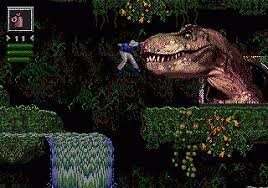
Until now, T. rex's closest relatives were a pair of tyrannosaurs named Tarbosaurus bataar and Zhuchengtyrannus magnus, which are found in modern-day China and Mongolia. Both species dated back further than T. rex, which suggests tyrannosaurs may have first emerged in what is now Asia, although this has never been confirmed.
The new findings suggest that Laramidia is a more likely origin of the tyrannosaur lineage, which would imply that these dinosaurs later spread to Asia. However, there is still uncertainty around this.
Laramidia was home to a wide variety of dinosaur species, including several other recent discoveries, such as Sierraceratops turneri — a horned herbivore similar to Triceratops that was described in a 2022 paper and was also previously misidentified as a different dinosaur species.
The new findings are further evidence that New Mexico is one of the best places in the world to search for new dinosaur species, study co-author Spencer Lucas, the curator of geology and paleontology at NMMNHS, said in a statement sent to Live Science. "Many new dinosaurs remain to be discovered in the state, both in the rocks and in museum drawers," he added.
https://www.livescience.com/animals...-predator-remarkable-skull-discovery-suggests
- Joined
- Jan 17, 2010
- Messages
- 4,529
- Reaction score
- 5,492
New flying dinosaur skeleton discovered on Isle of Skye in Scotland
The pterosaur, Ceoptera evansae, lived over 166 million years ago.ByLeah Sarnoff
Over 166 million years after its time roaming the Earth, scientists announced the discovery of a winged dinosaur skeleton that was found on the Isle of Skye in Scotland.
In findings published in the Journal of Vertebrate Paleontology on Feb. 5, researchers discovered the remains of a single pterosaur, named Ceoptera evansae, that's believed to have lived 166 to 168 million years ago during the Middle Jurassic period.
The research was led by scientists from the Natural History Museum, University of Bristol, University of Leicester and University of Liverpool.
Scientists report that Ceoptera evansae's incomplete fossil remains were first discovered in 2006 on a small beach along the coastline of Loch Scavaig, on the Strathaird Peninsula in the Isle of Skye.
Since then, researchers analyzed partial skeletons – remains of the shoulders, wings, legs and backbone – and used digital scanning to reveal multiple elements of the skeleton that were "otherwise inaccessible" due to being embedded in rock.
The skeleton of Ceoptera evansae is among the first of a pterosaur species to be fully digitally prepared, according to the report.
In the findings, researchers say Ceoptera evansae hails from a group of pterosaurs known as Darwinoptera, which were believed to mainly live in China, where the species' fossils have been discovered before.

Skeletal of Ceoptera evansae (NHMUK PV R37110), showing the material that is present (top, w...Show more Mark Witton
Making the discovery in Scotland has led researchers to suggest the Darwinoptera may have lived 25 million years longer than previously understood – from the Early Jurassic period to the latest Jurassic -- and gives insight into the diversity of the species.
The pterosaur species is among the earliest vertebrates known to have evolved to be able to fly and this new analysis indicates the species lived alongside avialans, the dinosaur species believed to evolve into modern birds.
Professor Paul Barrett, merit researcher at the Natural History Museum and senior author on the paper said in a press release for the paper that the discovery of this species in the UK was a "complete surprise."
"Ceoptera helps to narrow down the timing of several major events in the evolution of flying reptiles. Its appearance in the Middle Jurassic of the UK was a complete surprise, as most of its close relatives are from China," Barrett said. "It shows that the advanced group of flying reptiles to which it belongs appeared earlier than we thought and quickly gained an almost worldwide distribution."

Dr Liz Martin-Silverstone, a palaeobiologist from the University of Bristol and lead author on the paper, said the findings brings researchers "one step closer to understanding" the evolution of pterosaurs.
"The time period that Ceoptera is from is one of the most important periods of pterosaur evolution, and is also one in which we have some of the fewest specimens, indicating its significance," Martin-Silverstone said in the press release. "To find that there were more bones embedded within the rock, some of which were integral in identifying what kind of pterosaur Ceoptera is, made this an even better find than initially thought. It brings us one step closer to understanding where and when the more advanced pterosaurs evolved."
https://abcnews.go.com/Internationa...covered-isle-skye-scotland/story?id=107026985
- Joined
- Mar 3, 2023
- Messages
- 2,155
- Reaction score
- 3,629
Largest freshwater turtle was 6 feet long, 40,000-year-old fossils show
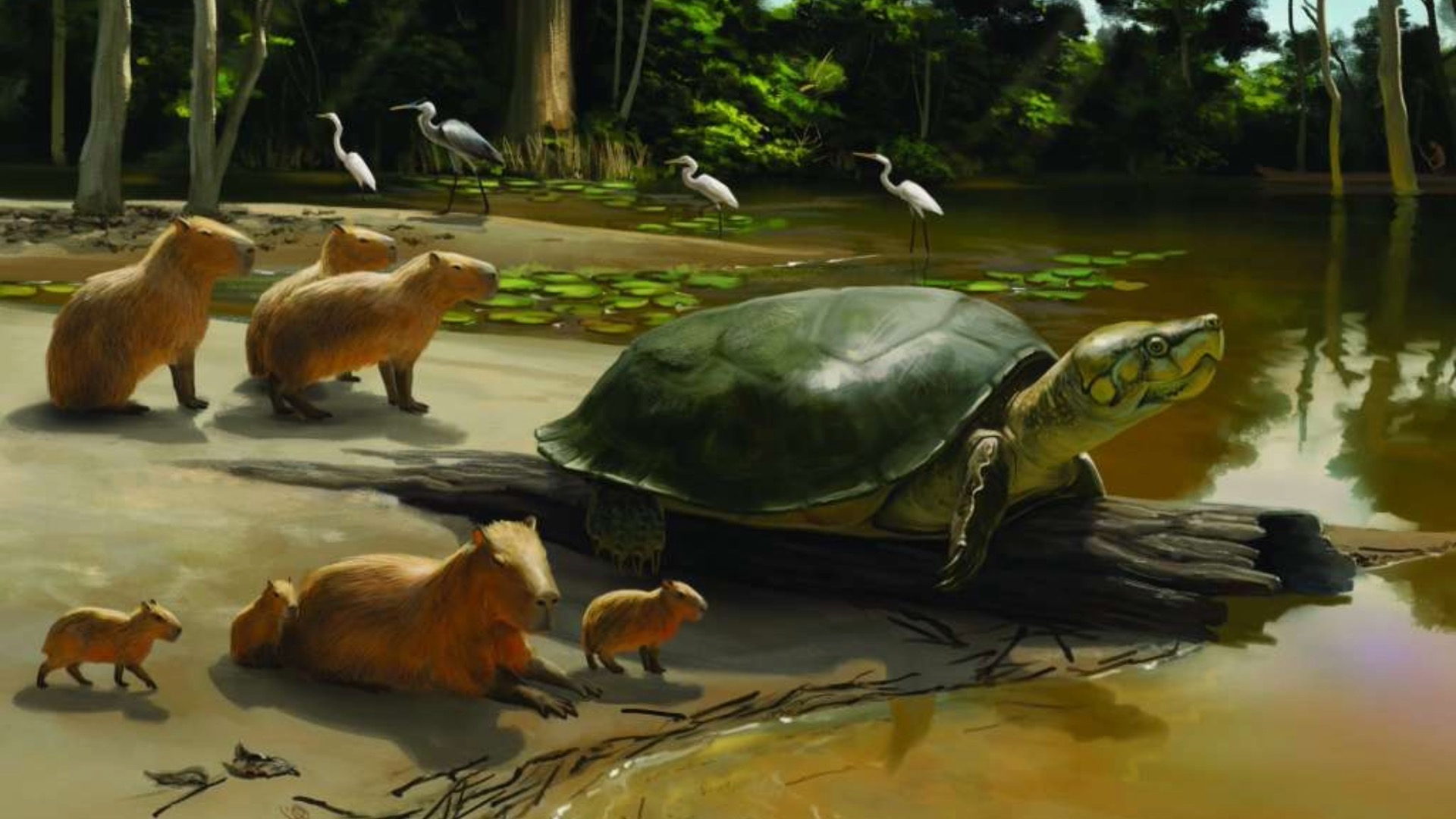
Largest freshwater turtle was 6 feet long, 40,000-year-old fossils show - Interesting Engineering
The finding shows that Peltocephalus maturin coexisted with early human inhabitants of the Amazonian region.
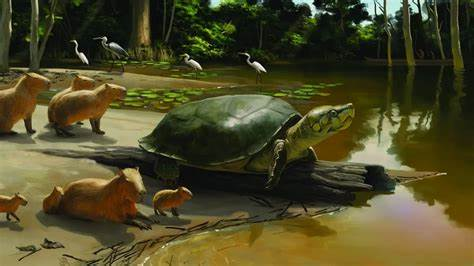
A new fossil find sheds light on ancient inhabitants of the region.
Fossil remains of a giant turtle have been unearthed in Brazil.
Peltocephalus maturin is the name given to the newly discovered species by Tübingen University researchers.
This species is identified as “one of the world’s largest freshwater turtles.”
During the late Pleistocene, the armored reptile existed for around 40,000 to 9,000 years.
- Joined
- Jan 17, 2010
- Messages
- 4,529
- Reaction score
- 5,492
Largest freshwater turtle was 6 feet long, 40,000-year-old fossils show
View attachment 1034785
Largest freshwater turtle was 6 feet long, 40,000-year-old fossils show - Interesting Engineering
The finding shows that Peltocephalus maturin coexisted with early human inhabitants of the Amazonian region.interestingengineering.com
A new fossil find sheds light on ancient inhabitants of the region.
Fossil remains of a giant turtle have been unearthed in Brazil.
Peltocephalus maturin is the name given to the newly discovered species by Tübingen University researchers.
This species is identified as “one of the world’s largest freshwater turtles.”
During the late Pleistocene, the armored reptile existed for around 40,000 to 9,000 years.
- Gamera?
- Joined
- Mar 3, 2023
- Messages
- 2,155
- Reaction score
- 3,629
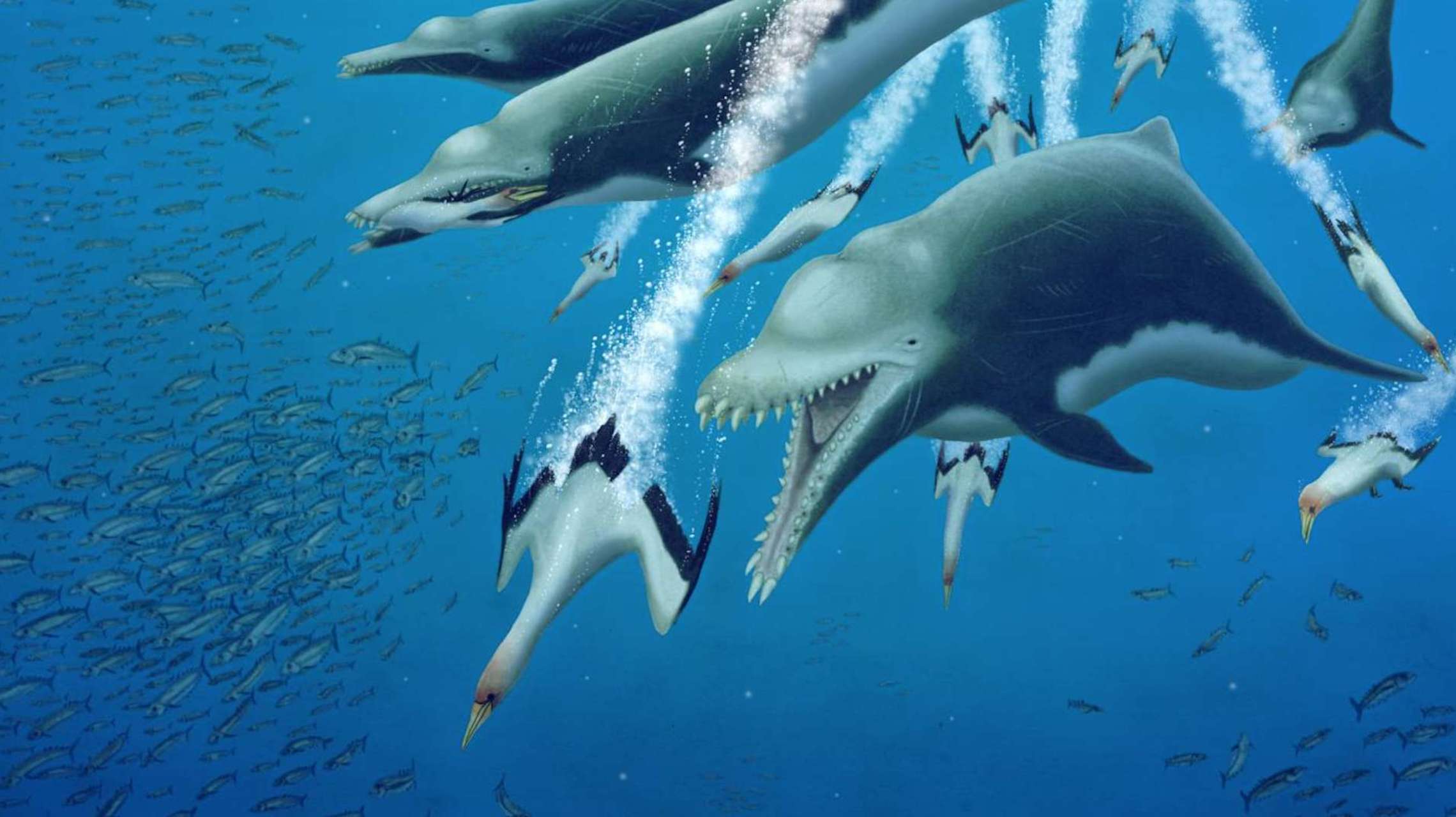
This savage prehistoric dolphin was the toothy terror of the primeval seas
Scientists from the College of Charleston in South Carolina have produced a new research paper on a new toothed dolphin from the Oligocene Epoch
Last edited:
- Joined
- Dec 18, 2004
- Messages
- 36,741
- Reaction score
- 31,852
That silhouette is sexy.A 2022 study described the skeleton of a new species of carcadontosaurs called Meraxes gigas. Like a T. rex, it had an enormous head and was very big: about 36 ft long.

And like the T. rex, it had tiny little arms.
The surprise was that this animal died 20 million years before the T. rex. So the tiny arms evolved independently.
The 93-million-year-old carnivore was named after a dragon from the literary saga that inspired the popular TV series ‘Game of Thrones’
Argentine, American, and Canadian paleontologists just announced a new species of giant carnivorous dinosaur – Meraxes gigas – first unearthed in 2012 in Neuquén, a province in Argentina’s Patagonia region. The first complete scientific study of this species has now been published in Current Biology, a journal that publishes original research across all areas of biology.
The species is a carcharondontosaurid theropod dinosaur, the largest predators from the Cretaceous age (90-100 million years ago). Like all theropods, they were short-armed and light-boned bipeds. Members of this particular family of dinosaurs were the longest of the theropods, measuring about 40 feet (12-13 meters) from snout to tail. One of its most distinctive features were its sharply serrated and curved teeth that resembled four-inch pruning saws
(Carcharodontosaurus means shark-toothed lizard in Greek). Weighing more than four tons, “the great dinosaur eater,” as the press release from the National University of Río Negro dubbed it, was once one of the largest carnivorous lizards in South America.
Paleontologist Juan Ignacio Canale, a researcher with Argentina’s National Council for Scientific and Technical Research (CONICET) and the National University of Río Negro, is the lead author of the Current Biology article. In a video interview from wintry Patagonia, Canale said it reminded him of one particular dragon. “I came up with the name because I love A Song of Ice and Fire,” the series of epic fantasy novels that inspired the hit Game of Thrones TV series. “I love the names George R. R. Martin chose for his dragons, and this one [Meraxes] fit perfectly because both are very large reptiles with giant skulls. We also needed a new name to distinguish Meraxes from two other giant carcharodontosaurs found in Neuquén: Giganotosaurus carolinii – the ‘villain’ from the last Jurassic World movie – and Mapusaurus. This is the third of its kind, like the three dragons from A Song of Ice and Fire,” said Canale.
Ten years of research funded by the municipality of El Chocón (the fossil-rich town in Neuquén), National Geographic, and the Field Museum in Chicago (USA) preceded this dramatic announcement. Unearthing the dinosaur went quickly in comparison. On the first day of fieldwork, they spotted an exposed spinal vertebra. “We started digging and more and more bones appeared. We were shocked,” said Canale. “We found a skull with no mandible, but with an intact maxilla and some teeth.” They were actually incipient teeth because unlike humans, dinosaurs and crocodiles produce several generations of teeth throughout their lives. The Neuquén Meraxes was 45 years old when it perished, making it one of the oldest carnivorous dinosaurs to be discovered.
Almost all of the arm and leg bones were found intact, “which is very unusual because in general, not much remained of the legs and arms of the largest carcharodontosaurs discovered from the Middle to Late Cretaceous period,” said Canale. This enabled the research team to identify a new and distinctive feature of this species – a powerful claw on the inner toe that is much larger and sharper than the other two.
https://english.elpais.com/science-...f-giant-dinosaur-discovered-in-argentina.html
- Joined
- Jan 17, 2010
- Messages
- 4,529
- Reaction score
- 5,492
Paleontologists Are Still Unraveling the Mystery of the First Dinosaur
Two hundred years after it was first named, scientists are just beginning to reveal the secrets of MegalosaurusRiley Black
Science Correspondent
February 8, 2024
:focal(800x602:801x603)/https://tf-cmsv2-smithsonianmag-media.s3.amazonaws.com/filer_public/08/82/0882d8ae-c6ef-4900-842d-2560066a35f4/gettyimages-89165747_web.jpg)
Paleontologists are still investigating what the carnivorous dinosaur Megalosaurus looked like. De Agostini via Getty Images
The reptilian giant found in England’s Stonesfield quarry needed a name. Throughout the 18th century and into the 19th, European naturalists in had been pondering strange and giant bones of long-dead creatures uncovered in quarries and sent to them through the tendrils of colonialism. For even longer, Indigenous peoples and others around the world had been wondering over similar remains of animals that clearly did not roam the planet anymore. But in the beginning of the 19th century, as science set about naming and describing fossilized creatures through its own language and standards, the curious bones needed proper titles. Among these early efforts, in 1824, University of Oxford geologist William Buckland dubbed the collection of skeletal pieces from Stonesfield Megalosaurus, the first dinosaur to receive a scientific name.
Buckland didn’t know that Megalosaurus was a dinosaur. That’s because the word “dinosaur” would not be coined for another 18 years. He was working during a time when the sciences of geology and paleontology were still very new, when the identity and broader significance of fossilized creatures were only just beginning to be understood. After all, it had only been in 1799 that naturalists finally accepted that extinction was a reality and Earth’s rocks were full of strange, bygone species. Megalosaurus was one such creature.

Working through the science of comparative anatomy, Buckland was sure that Megalosaurus was a giant reptile.
“Buckland himself recognized that the bones he described as Megalosaurus must have come from several different individuals of various ages and sizes, but were all from the same kind of animal,” says University of Oxford paleontologist Eliza Howlett. Those pieces represented a creature not quite like any known reptile. Even though the leg bones indicated an animal with upright, column-like legs, like most mammals, the details of the teeth were clearly reptilian.
He envisioned the animal as crocodile-like in nature. “The megalosaurus itself was probably an amphibious animal,” he wrote in his paper. Fossils of crocodile teeth and turtle shells found in the same quarry seemed to bolster the idea.

Two centuries later, we have a very different image of Megalosaurus, whose full name is Megalosaurus bucklandii in the Oxford geologist’s honor. Paleontologists have gone back to the original bones, as well as the dinosaur’s paper trail through the history of science, to reintroduce us to Megalosaurus as a bipedal predator that wandered along the Jurassic coastline. The dinosaur roamed what’s now England about 166 million years ago, a fairly large carnivore of its time at an adult length of more than 20 feet. Stalking about on two legs, the flesh-eater had a long and low skull of curved teeth and likely had short, stout arms tipped in large claws like its later relative Torvosaurus.
To this day, however, no one has ever found anything near a complete skeleton of Megalosaurus. The task of reconstructing the form of such a dinosaur is like trying to put together a puzzle when you have a pile of pieces from different sets, but no box. In addition to the bones Buckland originally described, experts attributed other fossils from England and elsewhere to Megalosaurus because they seemed roughly similar. On top of that, some pieces of Megalosaurus have gone missing.
American Museum of Natural History paleontologist Roger Benson notes that some Megalosaurus fossils that had been illustrated in the scientific literature, such as a jaw with teeth and the end of a femur that was infamously illustrated in the 1700s with the label “scrotum humanum” for its resemblance to a human body part, are not in any museum’s collections, and their whereabouts are unknown. All of this uncertainty has led to widely varying interpretations of Megalosaurus over time.
/https://tf-cmsv2-smithsonianmag-media.s3.amazonaws.com/filer_public/51/07/51078211-04fc-4814-8397-53a1e02ba91a/iguanodon_versus_megalosaurus_web.jpg)
An 1863 depiction of Iguanodon battling Megalosaurus
Megalosaurus started getting makeovers soon after the animal got a name. In 1842, in a paper that coined the word “dinosaur,” the English anatomist Richard Owen not only identified Megalosaurus as a dinosaur but refashioned its image into something between reptile and mammal.
Owen advised artist Benjamin Waterhouse Hawkins on creating a sculpture of his vision of Megalosaurus, as well as depictions of other dinosaurs, that was placed at London’s Sydenham Hill in 1853. The dinosaur was almost mammal-like, standing on all fours with a hump on its back, fitting Owen’s idea that dinosaurs were advanced reptiles unlike today’s lizards and crocodiles.
But as new finds in North America were unearthed in the 1850s and ’60s, such as the carnivorous Dryptosaurus, paleontologists revised dinosaurs yet again. Dryptosaurus and other new finds were bipedal, bird-like predators, and Megalosaurus was again adjusted to fit the new consensus.

Year by year and find by find, Megalosaurus was overshadowed. No complete skeleton appeared to reveal the dinosaur’s full form, and the fact that it was named based on isolated parts made it easy for experts to attribute other isolated bones and footprints to Megalosaurus. The dinosaur had become what experts often call a “wastebasket taxon,” or a biological category that researchers attribute various specimens to because they don’t seem to fit anything else. Eventually Megalosaurus was relegated to accounts of dinosaur history and was not especially relevant to new studies of how dinosaurs lived and evolved.
In the early 21st century, however, Benson took on the arduous task of disentangling the megalosaur mess and providing the dinosaur with a modern description as a doctoral project. “I was always really motivated to understand how different groups of dinosaurs were related to each other,” Benson says, and to do that for Megalosaurus required going back to the dinosaur’s historic record.
Some bones attributed to Megalosaurus turned out to belong to other dinosaurs. In 2009, for example, Benson named the theropod Cruxicheiros from historic Jurassic bones that had been labeled Megalosaurus and overlooked since their discovery. Likewise, Benson found that a toothy jaw fragment once thought to belong to Megalosaurus really represented a new dinosaur he named Duriavenator. For Megalosaurus itself, Benson recognized parts of the jaw, skull, forelimbs, hindlimbs, ribs and vertebrate that could confidently be deemed Megalosaurus, providing at least a rough look at the dinosaur’s skeleton. Incomplete as the skeleton seemed, experts could now be confident about which remains truly belonged to Megalosaurus when comparing similar dinosaurs and working out the shape of the dinosaur family tree.
Benson still hopes that more Megalosaurus fossils are out there awaiting discovery. Any new bones could offer important hints about the animal. “If we were looking for a wish list of what I would like to know about Megalosaurus,” says University of Oxford paleontologist Emma Nicholls, “then the answer would be: everything.” How Megalosaurus moved, how large it got and perhaps even how the dinosaur reproduced can only be guessed at by looking at related animals. “There are so many questions about Megalosaurus that it would be fantastic to have definitive answers for,” Nicholls says, and that curiosity is what drives paleontologists to keep going back to the rocks to search for more fossils.
Even so, experts have been showing more interest in the dinosaur than they did for most of the past century. “Scientists would often write that Megalosaurus was a generalized theropod,” Benson says, “but that’s a bit like saying, ‘We don’t know much about it, so let’s assume it’s kind of average.’” The reality is that Megalosaurus was probably more unusual than paleontologists expected.

Megalosaurus was not amphibious, as Buckland thought, but it seems that the dinosaur really did live along Jurassic waterways. The bones of Megalosaurus, Benson says, come from rocks that formed in coastal habitats where the remains of terrestrial plants and animals were being washed into shallow water and preserved there, suggesting that the dinosaur lived nearby. Given that Megalosaurus is related to the fish-eating spinosaurs, and spinosaurs themselves are categorized under the broader umbrella of megalosaurs, Megalosaurus may have been a fish-eater, too, representing the sort of dinosaur that gave rise to the specialized spinosaurs.
When Megalosaurus was first found, scientists hadn’t imagined such a creature could have existed. Makeover after makeover, the dinosaur kept changing. Now, 200 years after its name first appeared in print, we are truly just getting to know the first dinosaur, a Jurassic reptile that might have been more unusual than we ever knew. A hundred years from now, perhaps we’ll finally be able to envision Megalosaurus as more than a historic puzzle waiting to be completed.
https://www.smithsonianmag.com/scie...-the-mystery-of-the-first-dinosaur-180983672/
- Joined
- Jan 17, 2010
- Messages
- 4,529
- Reaction score
- 5,492
215 million-year-old crocodile ancestor that pre-dates dinosaurs identified
Aetosaurs are a reptile species that lived during the Triassic Period.ByLeah Sarnoff
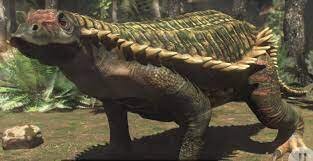
The recent identification of fossils from a heavily armored ancient crocodile ancestor species, known as aetosaurs, provides a glimpse into our world 215 million years ago.
The study, led by researchers at the University of Texas at Austin and published in the journal The Anatomical Record earlier this year, announces a new aetosaur species: Garzapelta muelleri.
"Unlike their dinosaurian relatives, aetosaurs are not a group of animals that are commonly talked about," William Reyes, a doctoral student at the UT Jackson School of Geosciences who led the study, told ABC News.
Aetosaurs are a species likened to modern crocodiles that lived during the Triassic Period, 229 million to 200 million years ago, which pre-dates the Jurassic Period, according to researchers, who further note aetosaur fossils have been discovered on every continent except Antarctica and Australia.

Garzapelta muelleri's fossilized dorsal carapace – the hard, armored plating that covered its back – is 70% complete, according to researchers, with major pieces from the neck and shoulder region to the end of its tail intact.
William Reyes, a doctoral student at the UT Jackson School of Geosciences who led the study, published in January, told Phys.org on Monday that the findings are remarkable because "Usually, you find very limited material."
The exterior of Garzapelta's skeleton is called the osteoderm, which is comprised of rock-hard plates and curved spikes both made of bone, according to the study.
"Take a crocodile from modern day, and turn it into an armadillo," Reyes told the publication, describing the ancient creature.
The study determined that Garzapelta's fossils date back 215 million years and that the species was largely omnivorous, contradictory to its modern cousin, the carnivorous crocodile.
The name Garzapelta muelleri is a nod to Garza County in northwest Texas, where the fossil was discovered, while "pelta" is the Latin word for shield, to signify the armor-like shell of the species. The second half of the name, muelleri, is a nod to Bill Mueller, the paleontologist from Texas Tech University who initially discovered the aetosaur's fossilized skeleton along with local amateur collector Emmett Shedd in 1989, according to Reyes, who noted Mueller died in 2019.
"They stumbled upon the fossil one day while prospecting the lands," Reyes told ABC News. "They noticed some bone fragments on the surface and decided to dig, realizing that they found an associated carapace of a large aetosaur."
After Mueller's death, Reyes said colleagues of the late scientist have "come together to finish some of Bill's projects, as he was working on very important material."
To determine that Garzapelta is, in fact, a new species of aetosaur, researchers compared the skeleton with those of similar ancient aetosaurs.
Co-author Bryan J. Small holding a pair caudal osteoderms of Garzapelta.
William Reyes/University of Texas at Austin
"The carapace of G. muelleri exhibits a striking degree of similarity between that of the paratypothoracin Rioarribasuchus chamaensis and desmatosuchins," researchers said in the study.
However, the unique qualities of Garzapelta's skeleton, from the formation of the osteoderm plates to the distinct markings and ridges on the species' bones, make it distinctly different from its aetosaur relatives, according to Reyes.
"Since its original discovery, many aetosaur specialists have been stumped by the taxonomic identity of Garzapelta," Reyes said. "Everyone agreed that it was indeed a new species as it exhibited several unique features."
Reyes reflected on the impact of his findings, saying, "Garzapelta is a great example of how cool these animals are and it is awesome to be in a position to introduce the public to the 'walking tanks' that existed millions of years before the ankylosaurian dinosaurs."
https://abcnews.go.com/Internationa...cestor-pre-dates-dinosaurs/story?id=108274279



